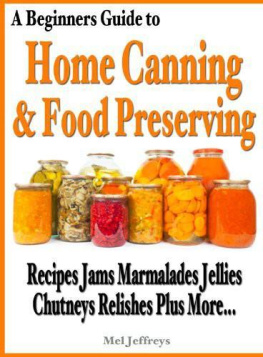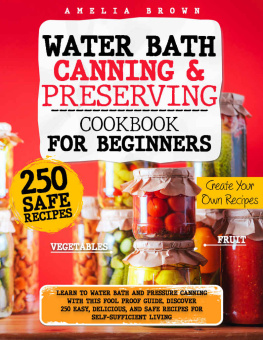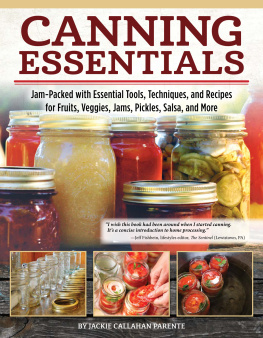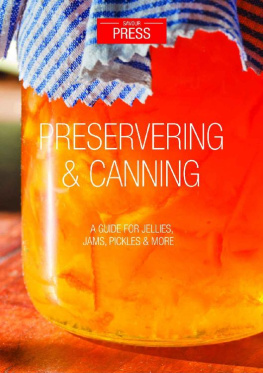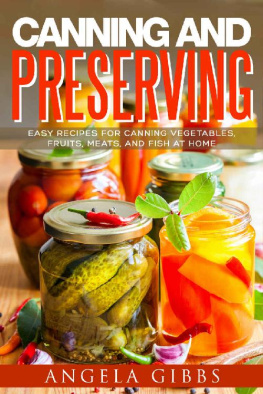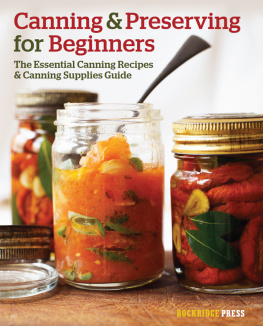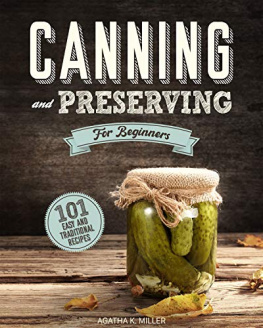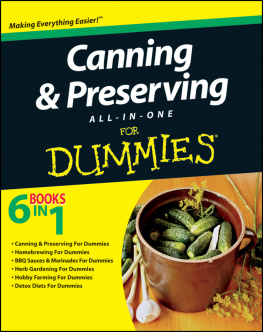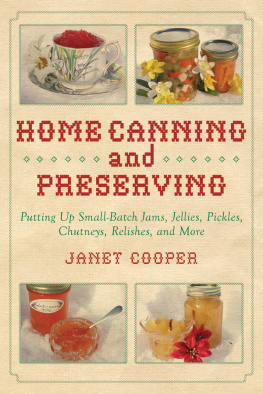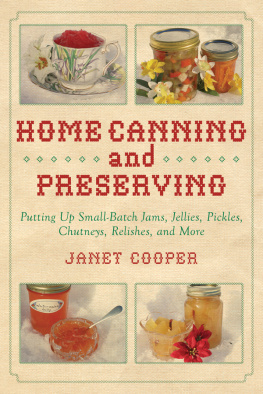A Beginners Guide to Home Canning & Food Preserving: Recipes, Jams, Marmalades, Jellies, Chutneys, Relishes Plus More
By Mel Jeffreys
2013 Mel Jeffreys
Table of Contents
Copyright
All rights reserved.
This book may not be reproduced in any form, in whole or in part, without written permission from the author.
Preface
It is an undeniable pleasure for the modern individual to look at the work accomplished by his or her own hands with a sense of pride and ownership. While humans will no longer generally starve to death if we dont preserve food at home (as we once would have done) we still enjoy the self-reliance that doing so brings.
Also, with the wide variety of food-borne illnesses, allergies, and intolerances, knowing exactly what is in our food, and how it was grown and prepared, gives many a peace of mind that is unquantifiable.
With the authors personal experience combined with that of other experienced home canners (for lack of a better term!) we bring to you over one hundred years of knowledge, wisdom, and insight. This information combined with up to date equipment and methodology data will be of great service to both the novice and experienced food preservationist.
The appeal of a back-to-nature movement or even economic strife can open a person up to developing forgotten skills. For these folks and the run of the mill home economist alike, preserving food in the home can bring about a great sense of security.

You may also want to visit us at our blog
SimpleLivingBlog.net or at https://www.facebook.com/Simple-Living
Other books you may enjoy by the Author Include:
A Beginners Guide to Keeping Backyard Chickens
A Beginners Guide to Organic Vegetable Gardening: Introduction to Composting, Worm Farming, No Dig Raised & Wicking Gardens Plus More
Introduction
Whether you are new to food preservation in the home, or are an old hand at it, this book will serve you well. The short history of the subject may provide a greater understanding of how various methods came to be used. Food safety, our highest priority, is also addressed early in the book.
Sources for tools, equipment, and food may introduce you to a new shop, or motivate you to explore your nearest farmers market. You may also decide to start a small container garden, or expand what you already have.
Additional information, such as adjustments for altitude and how to decide which method is right for you and the end product you wish to achieve is also provided in the first sections of this book. The tables provided assume you are at or near sea level. If this is not so, be sure to follow the recommended changes noted so that you and your preserved food remain safe.
As with any science and what is cooking if not a science? New discoveries may show a need to adjust a process or recipe. Whether you are a novice who just planted his or her first tomatoes in an old wine cask out on the balcony, or an experienced homesteader with antique Mason jars, it is important to keep abreast of new information regarding food safety. You might also find a new recipe to try out.
When the work is done, and tools are cleaned and put away for the next years harvest, you can look upon your work with a well-deserved sense of accomplishment.
History of Food Preservation
The need for food preservation has existed for as long as people have. It has not, however, always been as foolproof as the options available today. To be sure, the road to developing safe, predictable methods of preserving foods is littered with illness, worthless food, and even death. Thankfully, we get to reap the knowledge learned in the past. And if we use this information wisely, we can avoid repeating those mistakes.
Most areas of our world cannot be harvested all year. Nor is it wise to hunt all year even if your chosen prey is available. So, how do we feed ourselves in the off-season? We must prepare for these times, as they are most certainly coming. Food planning became more than going over the hill to see if the berry bushes were ripe yet.
Over time people developed ways of preserving food .
Dehydration , it was found, eliminated the moisture content of meats, fruits, herbs, and vegetables. This moisture was, in part, the cause of these foods to rot. Thinly sliced and hung or laid out in the sun to dry was the simplest means of food preservation.
Salting, brining, and smoking followed. All of these methods were inexpensive and simple enough that each household was able to care for its own needs.
As science progressed, bacteria and enzymes, and their effects on foods were discovered; preventions were learned. If food was brought up to a certain temperature, and then sealed in air and moisture resistant containers, removing any air in the container during the process, it could be stored for great periods of time. Canning, as this convenience was known, was invented.
Following World War II, as the electrical grid came to even the furthest out-lying farms and ranches, and prices for various metals came down with the increase of industrialization, freezing food became a reliable method of food preservation.
Although the canning process is the most labor intensive procedure, all methods promote a sense of pride, accomplishment, and self-reliance. Theres nothing like opening the pantry or freezer door on a frigid winters day, where the snow already up to the window sills is coming down so hard you cant see your mailbox, and finding row upon row of neatly labeled produce and meats and remembering once again that if the world ended outside your door, your family would still eat well.
Definition of Preservation Methods
Canning Processing food in airtight containers for preservation. This process uses containers made of aluminum, tin, or glass. Hot food is packed into the container and sealed either under pressure or a boiling water bath.
Dehydration Simply put, removing the water from food products for preservation. In early history, food was thinly sliced and placed on flat rocks in the sun to dry. Later, as people became less nomadic, racks were built for hanging long, thin slices of meat, think of jerky.
Commercially purchased dehydrators utilize mesh screens for racks, and electric fans to continually pull air across the food. The mesh screens allow the air to reach both sides of the food, while the fan speeds the process. Bacteria must have moisture to grow and multiply. Eliminating the moisture in food eliminates the bacteria that cause spoilage.
Example of a dehydrator available can be found at amazon.com: Waring DHR30 Professional Dehydrator
Dry-Salting This process draws moisture from food using a great deal of salt. This moisture dissolves the salt into brine, which inhibits the growth of micro-organisms. Only small or thin foods can be preserved this way. Small fish are often preserved in this manner. Done properly, fish can then be refrigerated for as long as two years.
Fermentation Although very similar to brining, fermentation requires very exacting measurements of salt, vinegar, and temperature. Caused by benign micro-organisms interacting with salt brine, they convert vegetable sugars into acids.
Dill pickles are made in this method, which can take three to six weeks to prepare. If processed (using pressure canning) following the fermentation period, these foods can be kept indefinitely.
Freezing Placing protected food in an environment that keeps it at 0 o F [-18 o C]. This method of food preservation is the easiest. It also keeps most foods closest to their original form. Not including the original investment in the actual appliance, freezing is a very economical way of preserving food. A quick blanch to halt enzyme production, and protection from the frigid, dry air is all that is required in preparation.
Next page
